State of the Economy: June 2019
Recent developments in the global, UK and Scottish economies, and analysis of the performance of, and outlook for, the Scottish economy.
Scottish Economy Update
Gross Domestic Product
Scotland’s economy continued to grow throughout 2018, continuing a pattern of stronger and more stable growth compared to 2015 and 2016.
Latest data for Q1 2019 show that this pattern continued into the start of the new year with annual GDP growth of 1.4% and quarterly growth of 0.5% – its highest rate of quarterly growth since the start of 2017.
Growth was broad based across the main industry sectors in the first quarter with growth strengthening in both the Production (1.8%) and Construction (2.0%) sectors.
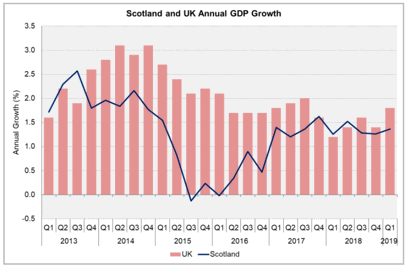
sector growth was also positive (0.1%), however was marginal and slower than at the end of 2018. While there was further growth in output from the Government and other Services sector (0.4%), this was offset by a fall in activity in the Business Services and Finances sector (-0.1%) alongside flat growth in Distribution, Hotels and Catering and Transport, Storage and Communication.
The Manufacturing sector provided the largest contribution to growth in the first quarter, with output increasing by 2.6%. This strong quarterly growth was reflected across the UK manufacturing sector as a whole and is consistent with business survey data which pointed to a strong pick-up in stockpiling activity ahead of the original March 31st Brexit deadline in preparation for any sudden changes to supply chains.
In Scotland, the strong growth in the Manufacturing sector output was primarily driven by the pharmaceutical sector and spirits and wines. Both sectors, which saw
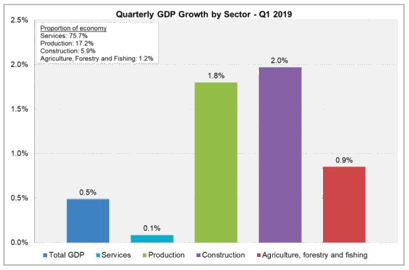
increases in exports over the quarter and been linked to potential stockpiling, accounted for more than half of the total GDP growth in Q1 2019.
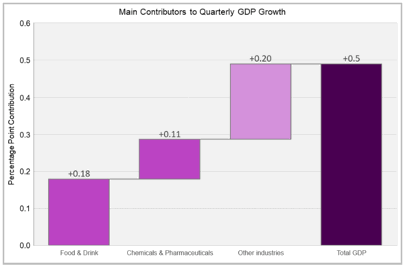
While uncertainty regarding the nature and timing of the UK’s EU departure continues, the data suggests that some of Scotland’s, and UK’s, GDP growth in the first quarter potentially resulted from one-off factors. If some of the growth observed at the start of 2019 was a result of stockpiling, this would be expected to result in a corresponding slowdown in growth in future quarters as companies run down their inventories accumulated.
New Statistics - Expenditure Components of GDP Growth
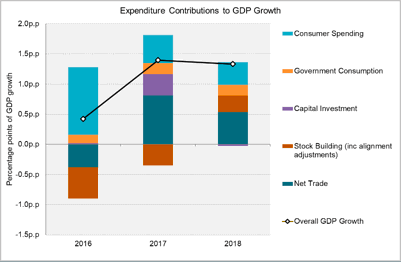
GDP analysis in the State of the Economy report is mainly based on the ‘Output’ approach to calculating GDP which measures the total production of goods and services. The ‘Expenditure’ approach to calculating GDP measures the total demand for goods and services through estimating consumer spending, government spending, capital investment and net trade (exports minus imports).
The latest Quarterly National Accounts Scotland[1] publication for Q4 2018 provided, for the first time, experimental statistics on the Expenditure measure of GDP in real terms. The results indicate that domestic demand in the economy, for consumer spending and capital investment, slowed over the last two years. This corresponds to a period of higher price inflation and weak real wage growth weighing on household finances, while there has also been an increase in Brexit uncertainty facing both consumers and businesses that, for the latter, has weighed on capital investment.
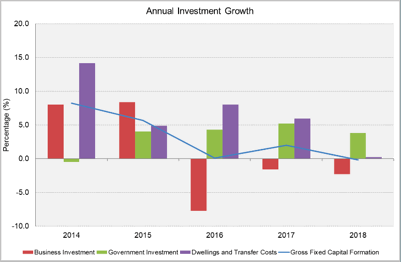
Net trade was the largest contributor to growth in 2018. Export growth in Scotland has been supported by more robust global growth alongside the tail end of the fall in exchange rate following the EU referendum supporting competitiveness. Slower import growth is likely to reflect the softness in domestic demand.
The fall in the contribution of capital investment over the past year has been offset by a rise and positive contribution from stock building. This reflects the reallocation of resources of firms from capital investment to contingency planning resulting from Brexit uncertainty. This can also be seen when disaggregating Gross Fixed Capital Formation, which shows that business investment has contracted between 2016 and 2018 while there has been continued positive growth in government investment and dwellings and transfer costs.
Retail Sales
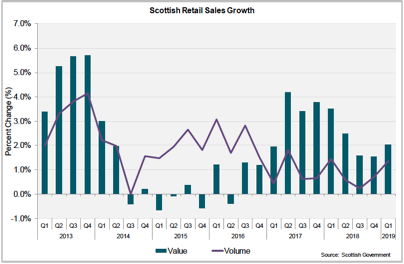
A driver of Service sector growth in the first quarter of 2019 was in the Wholesale and Retail sector which grew 0.3% over the quarter.
The Scottish Retail Sales Index[2] showed that retail sales strengthened in Q1 2019, growing 1.2% over the quarter (1.4% annually), up from 0.1% in the final quarter of 2018 (0.7% annually). This reflected a sharp acceleration in retail sales growth across Great Britain as a whole.
This positive start to the year came on the back of relatively subdued growth in 2018 of 0.7%. However, this is not uniform across the sector, with many high street retailers reporting very challenging trading conditions. For example, retail footfall[3] in Scottish town and city centre locations has continued to fall.
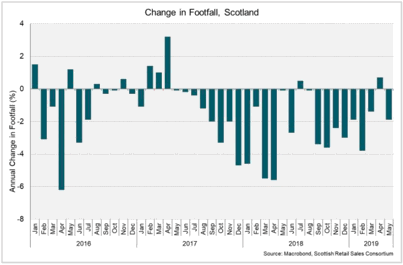
This has been driven by well documented structural changes in consumer behaviour which has weakened the finances of many high street retailers. There is a risk that such companies will not be well placed to withstand any further downturn in sales, or disruption to supply chains, as a result of continued Brexit related uncertainties.
Exports
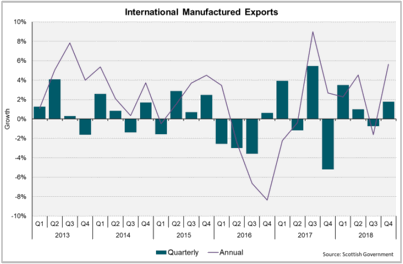
Stronger global growth, alongside the weaker value of Sterling has provided underlying support to Scotland’s international trading environment over the past 18-months, offsetting the wider challenges associated with global trade tensions and uncertainty surrounding the potential changes to trading relationships resulting from Brexit.
Scotland’s manufactured exports[4] grew by 1.8% in Q4 2018, rebounding from a slight contraction in the third quarter, and had grown 5.6% over the year – the second strongest rate of annual growth since mid-2013.
The main driver of stronger growth over 2018 was in food and drink exports which grew 13.1%, while there was also a return to growth of Engineering, Machinery and Metals exports (0.7%). This offset a fall in export growth of Refined Petroleum, Chemical & Pharmaceutical Products, which fell by 3.7% over the year.
More recent data from HMRC[5], a separate export survey, show that Scotland’s goods exports (including oil and gas) increased in cash terms by £3.8 billion (12.9%) to £32.8 billion over the year to March 2019, compared to the previous year. This increase was driven by a rise in oil and gas exports to the EU, which increased by £2.6 billion (39%) to £9.4 billion.
The Scottish Government’s Export Growth Plan for Scotland[6] was published in May setting out strategic choices to increase Scottish Exports. The following box shows the potential economic impacts of delivering on this plan.
Potential Economic Impacts of meeting Scotland’s Export Growth Plan
Exporting provides economy wide benefits through its contribution directly to GDP and its positive influence on productivity through the diffusion of new technology, competition, investment and economies of scale.
The value of Scotland’s international exports have increased by 58% since 2002. However, as a proportion of GDP, the value of Scotland’s international exports have decreased from 23% in 1998 to 20% in 2017, while that of many similar sized nations has increased. Some of this decline can be attributed to specific events such as the decline in Scotland’s electronics manufacturing, however the general trend suggests that Scotland has not been internationalising at the same pace as its competitors.
Scotland’s export growth plan ‘A Trading Nation: A Plan for growing Scotland’s Exports’ published in May 2019, sets a target for increasing Scotland’s international exports as a percentage of GDP from 20% to 25% by 2029.
The Scottish Government Global Econometric Model (SGGEM) was used to assess the potential impacts of meeting this target on the Scottish economy, compared to a baseline scenario in which international exports remain around 20% of GDP over the forecast period to 2029.
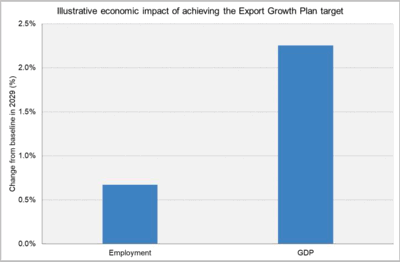
Meeting the export growth plan target implies increasing international exports as a share of GDP by 5 percentage points by 2029. To achieve this, the modelling assumed international exports being 25% higher in 2029 than in the baseline scenario in real terms. The increase was phased in linearly between 2019 and 2029, with international exports increasing by an additional 2.3% each year over the baseline.
The modelling estimates that meeting the export growth plan target in 2029 results in Scottish GDP potentially being 2.3% (£3.5bn) higher and employment being 0.7% (17,500) higher, than would otherwise be the case in the baseline scenario. The increase in GDP is larger than the increase in employment due to the fact that existing workers also see an increase in earnings.
Labour Market
Scotland’s labour market has continued to perform strongly into the start of 2019.
Latest data for February to April 2019[7] show the unemployment rate fell to 3.3% and remains close to its lowest ever rate of 3.2% earlier in 2019.
Alongside this, employment has increased by 34,000 over the past year to 2.7 million and the employment rate of 75.9% is its highest rate on record.
| Scotland Labour Market Statistics (Feb-April 2019) | |||
|---|---|---|---|
| Rates | Latest (%) | Quarterly (% p.t) | Annual Change (% p.t) |
| Employment* | 75.9 | 0.6 | 0.8 |
| ILO Unemployment** | 3.3 | -0.1 | -1.0 |
| Economic Inactivity* | 21.5 | -0.5 | 0 |
| Levels (‘000) | Latest | Quarterly Change | Annual Change |
| Employment (16+) | 2,702 | 26 | 34 |
| ILO Unemployment (16+) | 91 | -3 | -27 |
| Economic Inactivity (16-64) | 739 | -19 | 0 |
*Denominator = Working age population (16-64)
**Denominator = Total economically active
Growth in employment over the past year has been driven by full-time workers which have increased by 61,000, while part-time workers have fallen by 20,000.
Inactivity in Scotland – those neither in work or looking for work – has remained unchanged compared to a year ago though there has been a fall in the inactivity rate over the latest quarter to 21.5%.
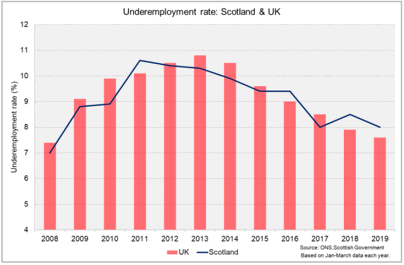
Latest underemployment data for the first quarter of 2019[8] also shows a fall in the underemployed rate in Scotland to 8.0%, down from 8.5% in Q1 2018, continuing its general downward trend since 2011.
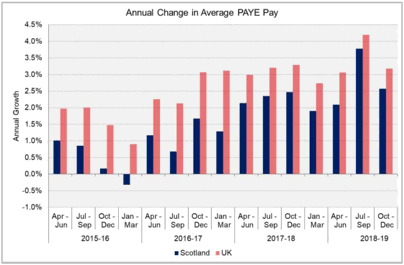
Tight conditions in the labour market, resulting in a challenging recruitment environment, continue to be reflected in business surveys[9]. Firms reported that permanent vacancies continued to rise in May 2019 alongside a decline in the availability of permanent candidates, however, both indicators have softened over the past year.
Tighter labour market conditions has fed through to stronger earnings growth. HMRC data for Scotland[10] show that average PAYE pay in October – December 2019 was 2.4% higher than a year earlier. This remains lower than pay growth in the UK as a whole (3.2%), however is in line with growth across 2017-18 as a whole and notably higher than in 2015-16 and 2016-17.
In real terms, pay growth has remained subdued, however the fall in inflation over the course of 2018 from 3% to 2.1% has had a positive impact.
Labour Productivity
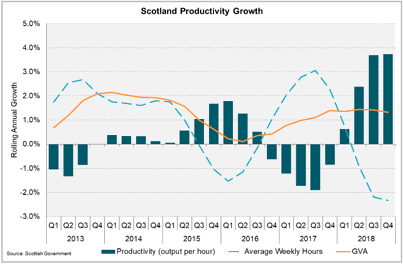
Labour productivity growth in Scotland has rebounded in 2018, compared to 2016 and 2017, reflecting, in part, the pattern of stronger output growth over that period.
In Q4 2018[11], labour productivity (output per hour worked) grew 0.5% over the quarter and 3.8% in 2018 as a whole, rebounding from a fall of 0.3% in 2017. Growth over 2018 was its fastest pace since 2010. This reflects that over the year, GVA grew 1.3% while the total number of hours worked fell 2.4%.
Over the longer term, between 2007 and 2018 labour productivity growth in Scotland continues to grow faster than the UK as a whole, growing 0.9% per annum on average compared to 0.2%, and is broadly in line with the EU average (0.8%).
Business Sentiment and Investment
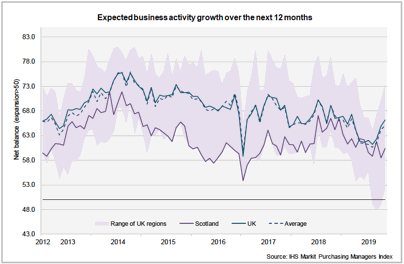
Business and consumer sentiment data provide useful insight into the expectations of firms and households and how that may influence their economic activity in the short term.
Business surveys have reported a weakening in the degree of business confidence over the past year[12] reflecting, in part, the uncertainty of Brexit and how it may impact the outlook for households and businesses.
The IHS Markit RBS Purchasing Managers Index reported that business confidence strengthened in May 2019 with Scottish businesses continuing to expect output to increase over the coming year. However, the degree of business confidence remained subdued by historical standards, with Brexit concerns and weaker growth forecasts weighing on sentiment.[13]
Two areas of business activity where uncertainty and weaker business confidence has had the greatest influence, has been on stockpiling and capital investment.
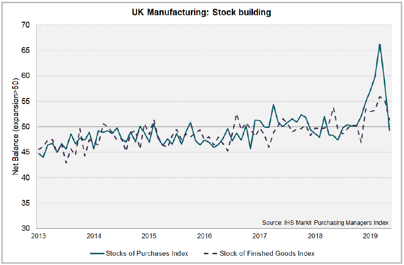
In the months leading up to the original UK EU exit date at end of March 2019, the UK Purchasing Managers Index reported stockpiling activity at record levels as firms undertook contingency planning to mitigate potential Brexit related disruptions. Such stockpiling ties up companies working capital, whilst the associated contingency planning that companies have had to undertake is likely to have diverted resources from growth enhancing activities.
The latest Bank of England survey analysis[14] suggests the level of UK nominal investment may be between 6%-14% lower than it would have been in the absence of Brexit uncertainties and will remain weak in the near term. Likewise, experimental statistics from the Scottish Quarterly National Accounts show that business investment has contracted in Scotland between 2016 and 2018. More recent business survey data[15] also signals that capital investment has fallen in the first half of 2019 with the indicator below its 5-year average.
Foreign Direct Investment
To complement understanding on changes in domestic business investment, the EY Attractiveness Survey[16] provides a source for understanding changes in Foreign Direct Investment into Scotland.
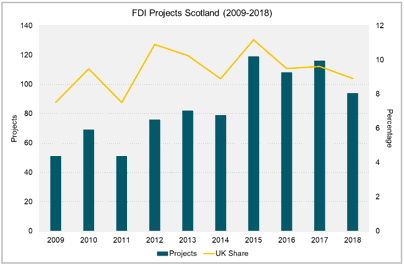
In 2018, Scotland attracted 94 inward investment projects. This represented a 19% fall in the number of projects compared to 2017 and reflected a wider slowdown in projects into the UK in 2018 (-12.5%).
Despite the decline in the number of projects in 2018, Scotland continued to attract more projects than any other region of the UK outside of London, however its share of total UK projects did decrease over the year.
There are a number of factors driving the fall in FDI project numbers in 2018. It partly reflects a wider slow-down in FDI activity across the EU. However in Scotland and the UK as a whole, it also appears to reflect Brexit uncertainty which may have led to the pausing of investment activity.
Fifteen percent of companies in the EY International Investors survey reported putting UK investment plans on hold as a result of the vote to leave the UK. That said, when asked which region of the UK they see as the most attractive for FDI, Scotland’s attractiveness more than doubled compared to 2017. As such, while perceptions of Scotland as an investment location within the UK improved over the year, the risk is that the underlying uncertainty for the UK as a whole overshadows investor perceptions on whether to invest in the UK or not.
Consumer Sentiment[17]
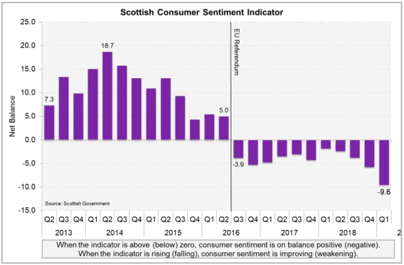
Alongside subdued business confidence, consumer sentiment in Scotland has also continued to weaken over the past year.
Consumer Sentiment has been negative in Scotland since the EU Referendum in 2016 and notably weakened in 2018 and into the start of 2019. The latest data for Q1 2019 showed a fourth consecutive quarterly fall in consumer sentiment and the indicator now stands at -9.6, its lowest level since the series began in 2013.
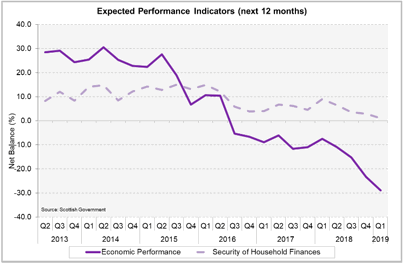
Looking more broadly at households expectations for the next 12 months, sentiment relating to the performance of the Scottish economy and household finances have both fallen to their lowest levels since the series began in 2013 and have weakened for the past four consecutive quarters. However, the decline in sentiment has been notably more prominent in households’ expectations for the economy, while households’ continue (on balance) to expect their financial position to improve over the coming year.
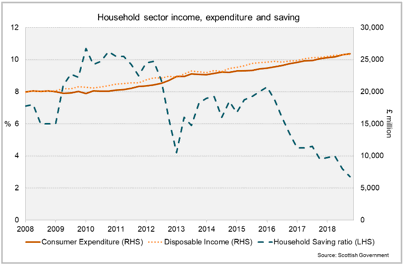
It is clear that Brexit concerns are being reflected in weakening consumer sentiment and expectations, which could have an impact on economic activity. For example, consumers may delay large purchases until the outlook becomes clearer. Alternatively, they may increase their savings with a corresponding reduction in current spending.
The recent declining trend in the household savings ratio – the proportion of disposable income which is left to households for saving or investment – is an important consideration for the flexibility that households may have for adjusting behaviour. In the advent of an external shock, consumers will automatically switch consumption behaviour which will reinforce any negative impacts. With a lower savings ratio the ability for households to respond is also reduced.
In Q4 2018, household expenditure is estimated to have increased by 3.0% compared to the same period as last year, while disposable income has only grown by 2.0%. This has resulted in the savings ratio falling to 2.7%, indicating that consumer spending is supported, at least in part, by reduced saving and/or new borrowing by households. This represent a risk to the economy.
The Role of Natural Capital in the Scottish Economy
Many of Scotland’s key industries such as food and drink, oil and gas and tourism are dependent on Natural Capital.
Natural Capital can be defined as the stocks of natural assets which include non-living and living things - for example, water, fish, minerals, timber, oil and gas – from which we derive a range of ‘ecosystem services’ through food and drink, fuel and energy, pollution removal and culture and recreation.
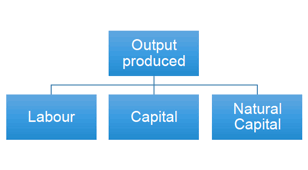
Typical models of the economy only link the amount of output produced to the quantity of labour and capital, and how efficiently they can be used (productivity). Including and valuing Natural Capital and the ecosystem services that are derived allows us to capture and monitor the contribution of natural assets to Scotland’s economic output and the impact that degrading our natural assets can have on our economic potential. In this way, natural capital is an asset that provides a flow of services on which output depends.
The Scottish Government published the first Natural Capital Accounts for Scotland in March 2019, which were prepared by the Office for National Statistics[18]. This included 10 service accounts, containing estimates of the quantity and value of ecosystem services being supplied by Scottish natural capital:
| Ecosystem Services derived from Natural Capital |
||
|---|---|---|
| Provisioning Services |
Regulating Services |
Cultural Services |
|
|
|
Natural capital asset values were determined using a Net Present Value approach to estimate the flow of ecosystem services that are projected to take place over the life of assets.
The estimates in the Scottish Natural Capital Accounts are currently experimental and partial (a number of ecosystem services are not included).[19] However, they provide an important bridge in recognising and valuing nature as a form of capital in its fullest sense. Also by recognising this as a stock, with subsequent and continuous flows, which underpins many eco-system services and key economic sectors and products, we can seek to protect, enhance and employ natural capital solutions to many policy outcomes - social, environmental and economic.
This is an important asset for Scotland and linking this to policy outcomes such as Wellbeing will be important going forward. We will return to this in future editions.
Scotland’s Economic Outlook
Looking forward, the latest independent forecasts of the Scottish economy reflect the stronger period of outturn growth in Scotland’s economy over the past two years. However, in the absence of any certainty on the timing and nature of the UK’s EU departure, they continue to assume some form of orderly Brexit transition.
The Scottish Fiscal Commission’s (SFC) latest forecasts do factor in the ongoing uncertainty associated with Brexit. In May, the SFC revised down its GDP forecast to 0.8% in 2019 and 0.9% in 2020, in part reflecting the negative impact that ongoing Brexit uncertainty is expected to have on business investment in Scotland. Once this uncertainty starts to fade, the SFC assumes that this is followed by a pick-up in growth to around 1.2% in 2021 to 2024.
The table below sets out a selection of independent forecasts and projections which, given their range in the short term, highlights the uncertainty of forecasting at this time.
| Independent Scottish GDP Growth Forecasts (%)[20] |
||||||
|---|---|---|---|---|---|---|
| 2019 |
2020 |
2021 |
2022 |
2023 |
2024 |
|
| Scottish Fiscal Commission |
0.8 |
0.9 |
1.1 |
1.2 |
1.3 |
1.3 |
| Fraser of Allander Institute |
1.1 |
1.4 |
1.5 |
- |
- |
- |
| EY ITEM Club |
1.0 |
1.4 |
1.5 |
1.7 |
- |
- |
| PWC |
1.2 |
1.6 |
- |
- |
- |
- |
Central to the outlook for Scotland’s economy over the next 12-24 months will be whether the EU Withdrawal Agreement is agreed by the UK Parliament well in advance of the new deadline at the end of October.
Early agreement, and the implementation of the associated transition period, would remove the immediate economic risks facing the Scottish economy, although questions over the nature of Scotland’s long term relationship with the EU would persist. However, if we approach the October deadline with the Withdrawal Agreement still not ratified, companies will again have to divert resources to contingency planning and stockpiling rather than business growth and investment.
Likewise, if the Withdrawal Agreement is not ratified and no further extension is sought or granted, the economic risks associated with a No Deal Brexit will again emerge. As has been highlighted in Scottish Government Analysis, No Deal Brexit – Economic Implications for Scotland[21], such an outcome risks pushing the Scottish economy into recession with a corresponding sharp rise in unemployment.
Contact
Email: OCEABusiness@gov.scot
There is a problem
Thanks for your feedback